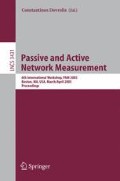Abstract
Communities of interest (COI) have been applied in a variety of environments ranging from characterizing the online buying behavior of individuals to detecting fraud in telephone networks. The common thread among these applications is that the historical COI of an individual can be used to predict future behavior as well as the behavior of other members of the COI. It would clearly be beneficial if COIs can be used in the same manner to characterize and predict the behavior of hosts within a data network. In this paper, we introduce a methodology for evaluating various aspects of COIs of hosts within an IP network. In the context of this study, we broadly define a COI as a collection of interacting hosts. We apply our methodology using data collected from a large enterprise network over a eleven week period. First, we study the distributions and stability of the size of COIs. Second, we evaluate multiple heuristics to determine a stable core set of COIs and determine the stability of these sets over time. Third, we evaluate how much of the communication is not captured by these core COI sets.
Access this chapter
Tax calculation will be finalised at checkout
Purchases are for personal use only
Preview
Unable to display preview. Download preview PDF.
References
Jin, E.M., et al.: The structure of growing social networks. Physics Review E 64, 845 (2001)
Kumar, R., et al.: The web and social networks. IEEE Computer 25(11), 32–36 (2002)
Kleinberg, J.: The Small-World Phenomenon: An Algorithmic Perspective. In: Proceedings 32nd ACM Symposium on Theory of Computing, pp. 163–170 (2000)
Kleinberg, J.: Navigation in a small world. Nature 405, 845 (2000)
Godfrey Tan et. al., “Role Classification of Hosts within Enterprise Networks Based on Connection Patterns,” in Proceedings of 2003 USENIX Annual Technical Conference, pp. 15–28, San Antonio, TX (June 2003)
Cortes, C., Pregibon, D., Volinsky, C.T.: Communities of interest. Intelligent Data Analysis 6(3), 211–219 (2002)
Cranor, C., et al.: Gigascope: a stream database for network applications. In: Proceedings of ACM SIGMOD (June 2003)
Author information
Authors and Affiliations
Editor information
Editors and Affiliations
Rights and permissions
Copyright information
© 2005 Springer-Verlag Berlin Heidelberg
About this paper
Cite this paper
Aiello, W., Kalmanek, C., McDaniel, P., Sen, S., Spatscheck, O., Van der Merwe, J. (2005). Analysis of Communities of Interest in Data Networks. In: Dovrolis, C. (eds) Passive and Active Network Measurement. PAM 2005. Lecture Notes in Computer Science, vol 3431. Springer, Berlin, Heidelberg. https://doi.org/10.1007/978-3-540-31966-5_7
Download citation
DOI: https://doi.org/10.1007/978-3-540-31966-5_7
Publisher Name: Springer, Berlin, Heidelberg
Print ISBN: 978-3-540-25520-8
Online ISBN: 978-3-540-31966-5
eBook Packages: Computer ScienceComputer Science (R0)

